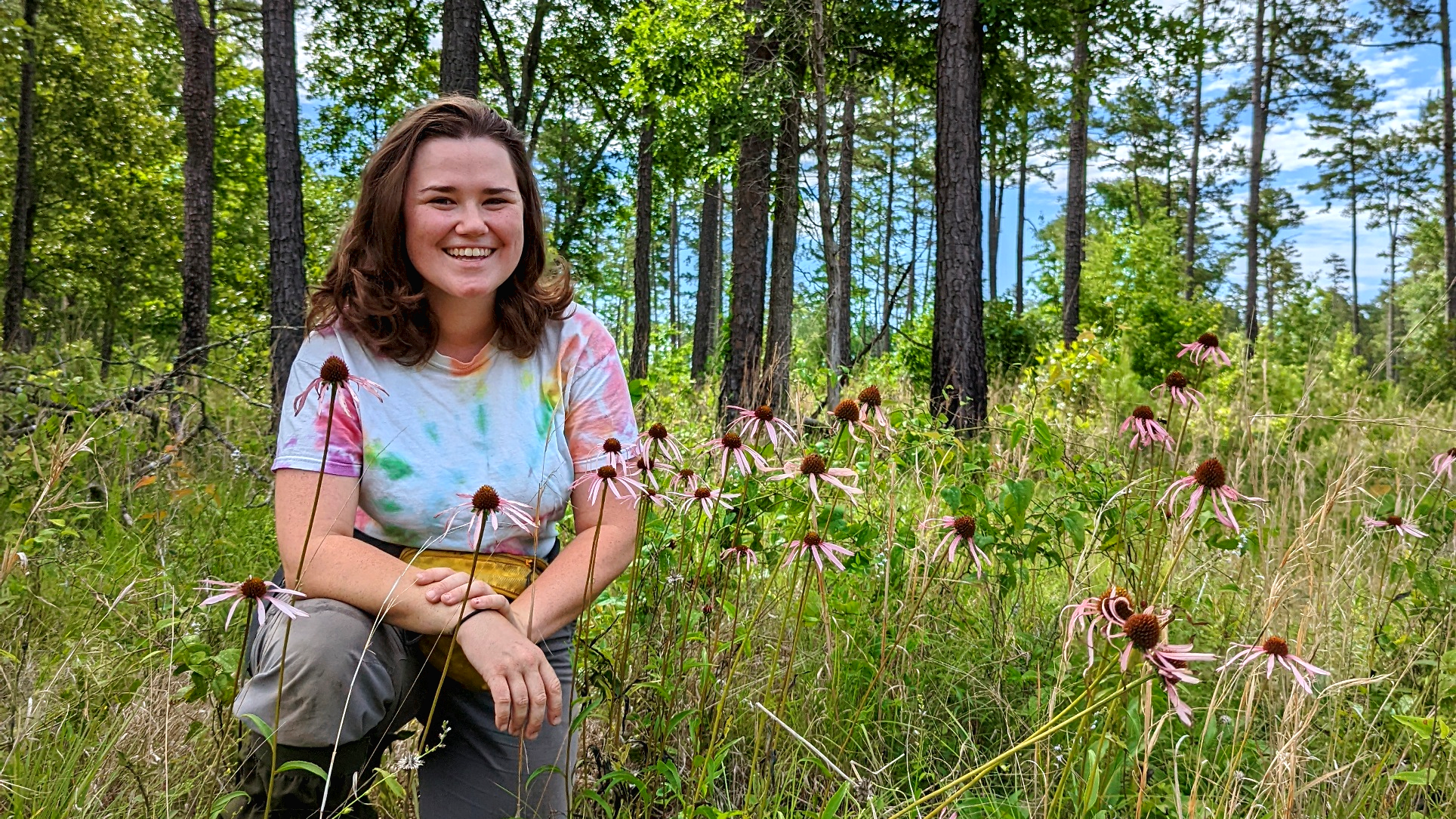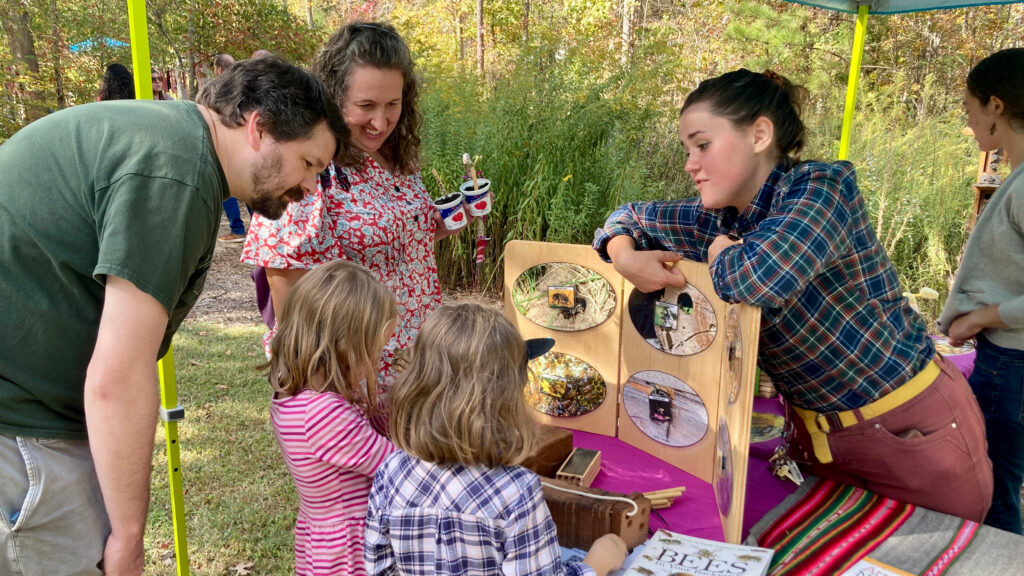Researcher Spotlight – Erin Eichenberger

2022-23 Global Change Fellow
PhD student, Department of Applied Ecology
Advisor: Dr. Rebecca Irwin, co-advised by Dr. Alexander Krings
Every year the Southeast Climate Adaptation Science Center funds a multi-disciplinary cohort of Global Change Fellows representing colleges across NC State University. Here are some highlights about 2022-23 Fellow, Erin Eichenberger and the applied research she’s conducting.
About You
What do you study?
I study the germination, establishment, and reproduction of plants in a native grassland community here in the Piedmont of North Carolina. My projects vary in scale from working with an endangered plant species up to community-level analyses of plants and pollinators. Through both basic and applied science, I hope to contribute to our understanding of the highly fragmented Piedmont Prairie community, and what needs to be done to preserve and restore it under changing climate conditions.
What (or who) influenced you to go into this field of study?
I became interested in plants when I bought my first houseplant to take with me as a buddy in college. It’s a Calathea lancifolia, a type of prayer plant, and its namesake comes from its daily spreading and contracting of leaves (like praying hands.) I had never seen a plant “act” like this, and it made me so curious about how plants respond to the world around them. My undergrad and post-bachelor’s work was on fragmented plant populations and questions about how they’re coping with their changing environments. As a North Carolinian, I was shocked to learn while interviewing for graduate programs that the second-growth forests like Umstead and Schenck that I grew up with as “natural spaces” were the result of tremendous land-use change. I have been thrilled to blend my interest in threatened plant communities with my love of North Carolina natural history through my graduate work.
What is your dream job?
I love research, but the most rewarding part of my day-to-day life as a grad student is the time I spend educating people through teaching, mentoring and outreach. My ideal position would be working in a public-facing job, such as at a museum or botanical garden, where I could split my time between conservation research and bringing the public into the fold of how incredible plants are, and the responsibility we have to protect them.
About Your Research

What is the most important thing that you’ve learned?
The most important thing I’ve learned is how to adapt to the challenges and randomness of working in the natural world. It’s frustrating when it’s raining, or a giant tree has fallen on one of your study plots, or not enough plants are flowering this year, but humans trying to control the chaos of nature has gotten us into a lot of trouble, historically. I’ve learned how to be more flexible with my plans and to stay light on my toes looking out for the next giant tree—skills the whole world will need as we move into an uncertain climate future!
Who will benefit from your research?
I work with entities like the North Carolina Plant Conservation Program, which manages rare plant communities and populations of focal species in my research. I hope that my work’s findings on suitable habitat and best management practices will be helpful in planning conservation strategies for prairie remnants. I also hope that through outreach and mentoring that I can raise public awareness and interest in this amazing prairie system. I think there is huge cultural value to understanding the natural history of the area you’re from, and I love sharing the story of the North Carolina Piedmont with my students and coworkers.
How can your research be used to inform management decisions?
All of my research projects have implications for managing plants and insects in this prairie system. For my work on the rare southeastern coneflower species Echinacea laevigata, investigating the effect of light availability on growth and reproduction in the species will help develop management strategies for populations threatened by overgrowth of trees. We know that many species in this grassland system such as E. laevigata benefit from high light, so my work investigating mechanical thinning and herbicide application as prairie restoration strategies will help land managers plan management activities. While prescribed burning is the gold standard for grassland maintenance, changes such as increasing urbanization and increasingly hot and humid conditions will require alternate solutions.
About Your Global Change Fellow Experience
How do you expect the SE CASC Global Change Fellows Program to impact you and your work?
Being a GCF has reshaped the larger goals of my work. In previous research roles, I have focused on understanding the impacts of historical change and how it shaped extant communities. Now I am looking forward to future changes that will challenge plant and insect communities, with a perspective informed both by lessons from the past and an increased understanding of geophysical, legislative and cultural factors involved in mitigating climate change.
What has been the most rewarding part or your favorite part of being a SE CASC Global Change Fellow?
The most rewarding part of being a GCF is how much I have learned about successful ongoing efforts to educate the public on climate change and collaborations with local governments and tribal partners to develop climate adaptation strategies. It’s easy to feel gloomy about our future while cooped up in a lab or alone in the field, so learning how people are working to make actionable strategies through boots-on-the-ground work with communities is fantastic for morale. I’ve learned a ton about how successful partnerships form and work, and I feel much better equipped to collaborate on climate problems.
What advice would you give to a student that is interested in getting involved in your field?
Someone who wants to pursue ecology likely already has a large interest in the natural world, but I would particularly recommend cultivating curiosity about the area where you live. What are the natural plant communities? What animal species lived there before urban development, and what species persist? Who lived here historically, and how has human land use changed over time? What changes will happen in the future, and how will they influence remaining natural areas? When you have a personal connection to a subject or place, curiosity and exploration come easily. Background research, question-asking and hypothesis-formulating are all practicable skills that you don’t have to restrict to your academic life. Plus, it’s fun to be the “nature friend” who people know to send blurry bird photos to for identification.
You can learn more about Erin’s work and the students she works with at her website, eichenresearch.wordpress.com
